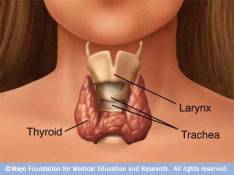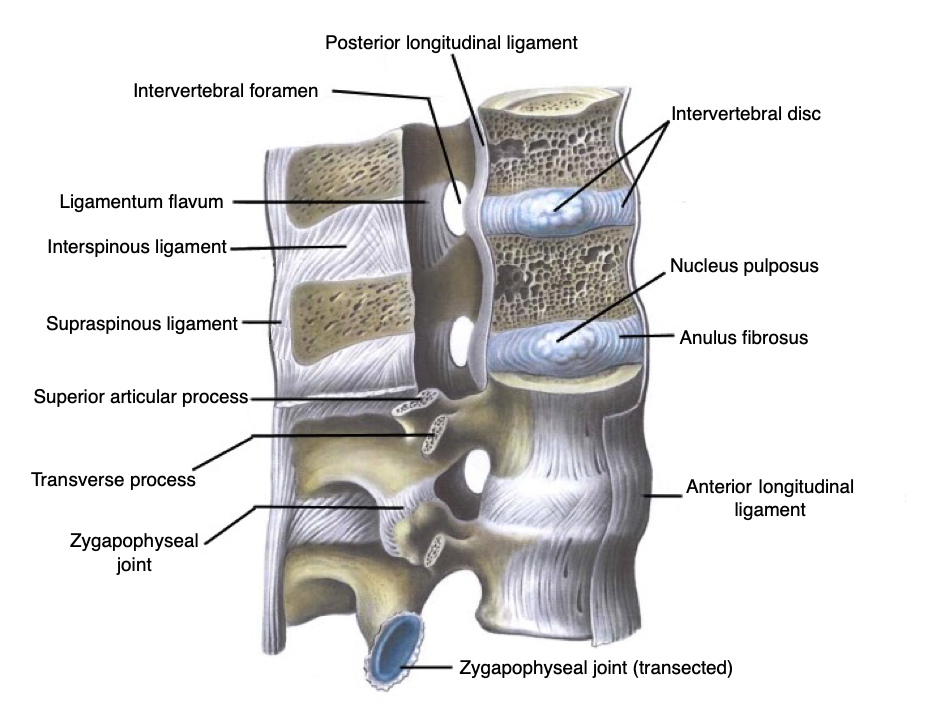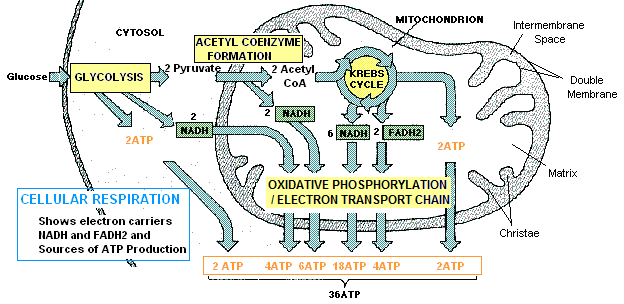The Biological Clock

A biological clock is a time-keeping system that ensures our ability to adapt to and exist in harmony with the 24 day / night and seasonal changes of the earth. By generating 24-hour circadian rhythms in our body for hormonal release and cardiovascular, behavioral and other functions. The body contains several such clocks.
The Master “Biological Clock”(SCN) (technically the Suprachiasmatic nucleus)
In humans (and other mammals), it is housed in the brain’s hypothalamus. This is the master pacemaker of our body’s circadian timekeeping system.
The SCN consists of a pair of pinhead-size regions. Each containing only about 10,000 neurons out of the brain’s estimated 100 billion neurons.
The SCN receives information about environmental lighting. From the retina via optical nerves and indirect pathways, thus forming the main link between external and internal times. (There is also some evidence that the pineal gland may be able to directly sense the light).
- The SCN synchronises the peripheral clocks throughout the body with external time, more or less on a 24-hr. cycle. The emerging concept is that output signals from the master clock communicate with peripheral clocks located in other areas: E.g. the brain, heart, lung, GI tract, liver, kidney and fibroblasts – resulting in integrated circadian rhythms for the body’s physiological functions.
- Via humoral pathways. E.g. rhythmically released hormones like ACTH from the pituitary, MELATONIN from the pineal, and corticoids (such as CORTISOL) from the adrenals.
- Via the autonomic nervous system
- Via the regulation of activity, nutrient uptake and core body temperature. E.g. SCN controls cycle/rhythm of body temperature cycle. The temperature is lowest in the biological night and rises in the biological daytime. This fluctuation persists even in the absence of sleep. Activity during the day and sleep during the night reinforce (entrain) this cycle of changes in body temperature.
The circadian rhythm
Almost every physiological variable in living (and developing) organisms shows a circadian rhythm. Humans (and most vertebrates) have an internally generated rhythm with a period of slightly more than 24 hours – i.e. a true circadian rhythm.
The existence of a circadian or daily rhythm is apparent in physiological, pharmacological and pathological events – including:
- For activity/rest
- Body temperature
- Plasma levels of hormones. E.g. MELATONIN, CALCITRIOL, RENIN, ANGIOTENSIN, ALDOSTERONE, NOREPINEPHRINE, INSULIN, PROLACTIN, GROWTH HORMONE, THYROTROPIN, ATRIAL NATRIURETIC PEPTIDE, VASOPRESSIN.
- Childbirth. In most women, natural labor begins after midnight and delivery occurs around early morning. Glattre and Bjerkedal, 1983
- Cardiovascular function
- Behavior
- Response to a glucose-tolerance test;
- Performance variables – E.g. reaction time, reading error, subjective alertness, working memory speed, self-chosen work-rate;
- Birth and death rate;
- Pharmacokinetics and effects of drugs;
- Risk for cardio- and cerebrovascular attacks Wever 1979, Reilly et al. 1997, Schwartz 1997, Lemmer 1999
- Various functions of:
- The heart and circulation – E.g. cardiac output, heart rate, blood pressure;
- The respiratory system – E.g. minute volume, oxygen consumption, carbon dioxide production
- The kidneys – E.g. glomerular filtration rate, urine flow rate, electrolyte excretion. (Wever 1979, Reilly et al. 1997).
- Premature babies exposed to cycled light grew faster. Study involved 62 babies born at least 10 weeks prematurely and weighing, on average, 2 pounds. They were randomly assigned to three groups with different lighting conditions. It was found that those exposed to cycled light earlier grew faster -at least 23 grams more per week – than those who got cycled light near the end of their hospitalization.
Brandon DH, Holditch-Davis D, Belyea M. Preterm infants born at less than 31 weeks’gestation have improved growth in cycled light compared with continuous near darkness. J Pediatr. 2002 Feb;140(2):192-9. PubMed
Circadian rhythms are of two general types
(1) Exogenous circadian rhythms. Directly produced by an external influence, such as an environmental cue. E.g. Light entering eyes. Since it is not generated by the organism itself, if the environmental cues are removed, the rhythm ceases
(2) Endogenous circadian rhythms. Driven by an internal, self-sustaining biological clock rather than by anything external to the organism. E.g. cyclical changes in core body temperature are endogenous. They are maintained even if environmental cues are removed.
The endogenous circadian rhythm persists in the absence of time cues, but can be entrained (synchronized) to the 24-hour day:
- Primarily by light / dark cycles.
Other factors involved in entrainment include:
- Imposed behavior such as forced activity and rest;
- Social and nutritional feeding cues;
- Temperature variations;
- Knowledge of clock time;
- Certain drugs;
- Possibly electromagnetic fields;
- MELATONIN
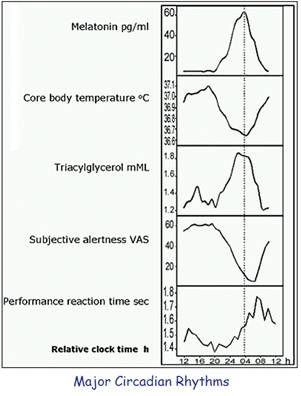
The circadian rhythms vary for different species
- Humans. CORTISOL peaks at 8 am, temperature at 2pm and MELATONIN at 2a.m.
- Nocturnal animals (E.g. rat). CORTICOSTERONE peaks in the evening and temperature at night, whereas MELATONIN matches humans.
Functions of the biological clocks
The most important function of these clocks is to regulate the biological rhythms in the 24 hour sleep/wake cycle:
- Making you sleepy at night /Awake during the day
- Maintaining important night-time janitorial work on your immune system
- Performing psychological balancing/reconciliation activity (equally important, but not well understood).
The SCN (“Biological Clock”) regulates MELATONIN production and release into bloodstream by being either ON or OFF – determined by the presence of light or darkness perceived by the eyes:
- “Being OFF in the presence of light the “Biological Clock” signals the pineal gland NOT to produce MELATONIN. By sending messages that block the pineal’s release of a chemical messenger, called NOREPINEPHRINE (NE) (from postganglionic neurons from the superior cervical ganglia), which is needed for the pineal to make MELATONIN. i.e. The absence of the NE messenger ensures that MELATONIN is not produced.
- Being ON in darkness the “Biological Clock” signals the pineal gland to produce MELATONIN. The presence of darkness sends messages via nerve connections from the eyes (the retinohypothalamic tract), that has two concurrent effects:
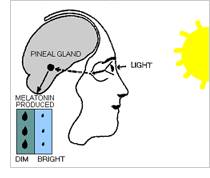
(1) Instructs a group of cells (the superior cervical ganglion) to make the chemical messenger NE, but it can not be released until . . .
(2) Darkness tells the “Biological Clock” to remove its blocking effect on the release of the chemical messenger NE. Thereby permitting the pineal gland to produce MELATONIN and secrete it into the bloodstream.
MELATONIN feeds back to the SCN to regulate its activity. Most of the brain receptors for MELATONIN are located in the SCN (in mammals)
MELATONIN supplementation:
- Can produce shifts in circadian rhythms in a number of species. Including rats, sheep, lizards, birds, and humans. Effects are most clearly evident when MELATONIN is given in the absence of light input. Thus, for example, giving MELATONIN to blind people can help set their biological clocks.
Evidence that supplement MELATONIN promotes sleep is inconclusive
- Potential side effects of long-term administration of MELATONIN remain unknown. Its unsupervised use by the general public is discouraged.
Seasonal Rhythms. In addition to synchronizing daily rhythms, biological clocks can affect rhythms that are longer than 24 hours, especially seasonal rhythms
Some vertebrate animals have reproductive systems that can sense day length by the amount of MELATONIN secreted:
- In hamsters. The short days and long nights of winter turn off the reproductive systems
- In sheep the opposite occurs. The high levels of MELATONIN that inhibit reproduction in hamsters stimulate the reproductive systems of sheep, so they breed in winter and give birth in the spring.
Body’s master clock (SCN) must be entrained to match environmental day length
The clock must be entrained, or reset, to match the day length of the environmental light / dark (i.e. day/night) cycle. Because the circadian clock in most humans has a natural, inherent day length of just over 24 hours,
The cue that synchronizes the internal biological clock to the environmental cycle is light. Photoreceptors in the retina transmit light-dependent signals to the SCN. Interestingly, our usual visual system receptors, the rods and cones, are apparently not required for this photoreception. Special types of retinal ganglion cells are photoreceptive, project directly to the SCN, and appear to have all the properties required to provide the light signals for synchronizing the master clock. At the SCN, the signal interacts with several genes that serve as “pacemakers.”
Diagram shows a day-by-day representation of one individual’s sleep/wake cycle
The dark gray lines indicate periods of sleep, and the light gray lines indicate periods of being awake
Days 1-9 represents this individual’s normal sleep/wake cycle. Under these conditions, the individual is exposed to regularly timed exposure to alternating daylight and darkness, which has entrained this person’s sleep/wake cycling to a period of 24 hours.
Days 10-34 this individual has been isolated from normal environmental cues like daylight, darkness, temperature variation, and noise variation
(a) This individual’s sleep/wake cycle continues to oscillate in the absence of external cues, showing that this rhythm is endogenous, or built in.
(b) In the absence of external cues to entrain circadian rhythms, this individual’s clock cycles with its own natural, built-in rhythm (just over 24 hours long) – Consequently, without environmental cues, the individual goes to bed about one hour later each night. After 24 days, the individual is once again going to bed at midnight, the time to which the SCN was previously entrained.
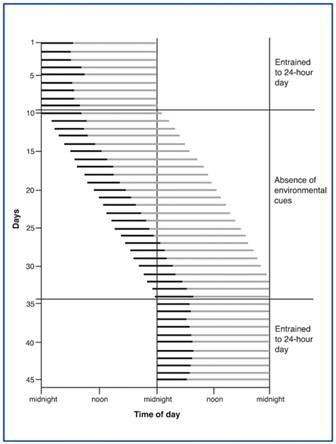
Jet lag. Results from the inability of our circadian clock to make an immediate adjustment to the changes in light cues that an individual experiences when rapidly crossing time zones. After such travel, the body is in conflict. The biological clock carries the rhythm entrained by the original time zone, even though the clock is out of step with the cues in the new time zone. This conflict between external and internal clocks and signals is called desynchronization.
- Note that ALL the body rhythms are out of sync. Affects more than just the sleep/wake cycle, and they take a number of days to re-entrain to the new time zone.
- Eastward travel generally causes more severe jet lag than westward travel. Because traveling east requires that we shorten our day and adjust to time cues occurring earlier than our clock is used to.
| Discovery of Biological Clock |
|---|
The 20th century saw the recognition that all living beings, including unicellular organisms, possess a biological clock system that measures time in near 24-h (circadian) units resulting in rhythmic patterns with a period of 24-h, termed circadian rhythms. The tendency of some organisms to sleep at night and some during the day, and the fact that some plants open their leaves during the day and close them at night, are common observations. The reasonable assumption that these are passive responses to the day/night changes in the environment was proven wrong by a simple yet brilliant experiment performed in the 18th century. In 1729, French astronomer Jean Jacques d’Ortous de Mairan showed that the upright movement of the leaves of the plant Mimosa pudica at nighttime and the opening of these leaves during the daytime hours continued over several days when the plant was maintained in constant darkness, indicating that the leaves’movement followed an endogenous 24-h clock. |














